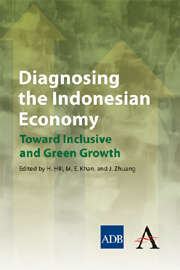Book contents
- Frontmatter
- Foreword
- Preface
- Author Profiles
- Abbreviations and Acronyms
- Contents
- 1 Introduction
- 2 Development Policies and Performance
- 3 Critical Constraints to Growth
- 4 Critical Constraints to Reducing Poverty and Inequality
- 5 Macroeconomic Management
- 6 Industrialization: Patterns, Issues, and Constraints
- 7 Infrastructure Development: Challenges and the Way Forward
- 8 Human Capital and Economic Development
- 9 Economic Growth, Employment Creation, and Poverty Alleviation
- 10 Poverty Reduction: The Track Record and Way Forward
- 11 Decentralization
- 12 Making Indonesia's Growth Green and Resilient
- Index
7 - Infrastructure Development: Challenges and the Way Forward
Published online by Cambridge University Press: 05 May 2012
- Frontmatter
- Foreword
- Preface
- Author Profiles
- Abbreviations and Acronyms
- Contents
- 1 Introduction
- 2 Development Policies and Performance
- 3 Critical Constraints to Growth
- 4 Critical Constraints to Reducing Poverty and Inequality
- 5 Macroeconomic Management
- 6 Industrialization: Patterns, Issues, and Constraints
- 7 Infrastructure Development: Challenges and the Way Forward
- 8 Human Capital and Economic Development
- 9 Economic Growth, Employment Creation, and Poverty Alleviation
- 10 Poverty Reduction: The Track Record and Way Forward
- 11 Decentralization
- 12 Making Indonesia's Growth Green and Resilient
- Index
Summary
Overview
In this era of globalization and international competitiveness, sustainable socioeconomic development and poverty reduction cannot be achieved without adequate and efficient infrastructure. Several studies have examined the relationship between infrastructure and economic growth in Indonesia. For example, Mawardi (2004) showed that infrastructure had a positive impact on Indonesia's economic growth. A recent empirical study by Mustajab (2009) estimated that a 1% increase in infrastructure investment contributes 0.3% to Indonesia's gross domestic product (GDP). This supports the contention that adequate infrastructure is a major driver of sustainable economic growth and poverty reduction in Indonesia.
However, the current state of Indonesia's infrastructure is far from encouraging, and it came as no surprise that the business community identified inadequate infrastructure (in terms of both quantity and quality) as the second biggest impediment to doing business (compared with 10th in Malaysia and Thailand). The slow pace of infrastructure development and its poor quality are attributable to the low level of investment by both the public and private sectors in Indonesia. The situation has deteriorated since the 1997 Asian financial crisis—current investment in infrastructure is about 3.5% of GDP versus the pre-crisis level of approximately 8% in 1997 (Figure 7.1).
Foreign direct investment (FDI) is an important source of financing for the infrastructure sector. Like domestic private investment, FDI flows have been recovering slowly in recent years but remain lower than the precrisis level.
- Type
- Chapter
- Information
- Diagnosing the Indonesian EconomyToward Inclusive and Green Growth, pp. 227 - 274Publisher: Anthem PressPrint publication year: 2012
- 1
- Cited by



